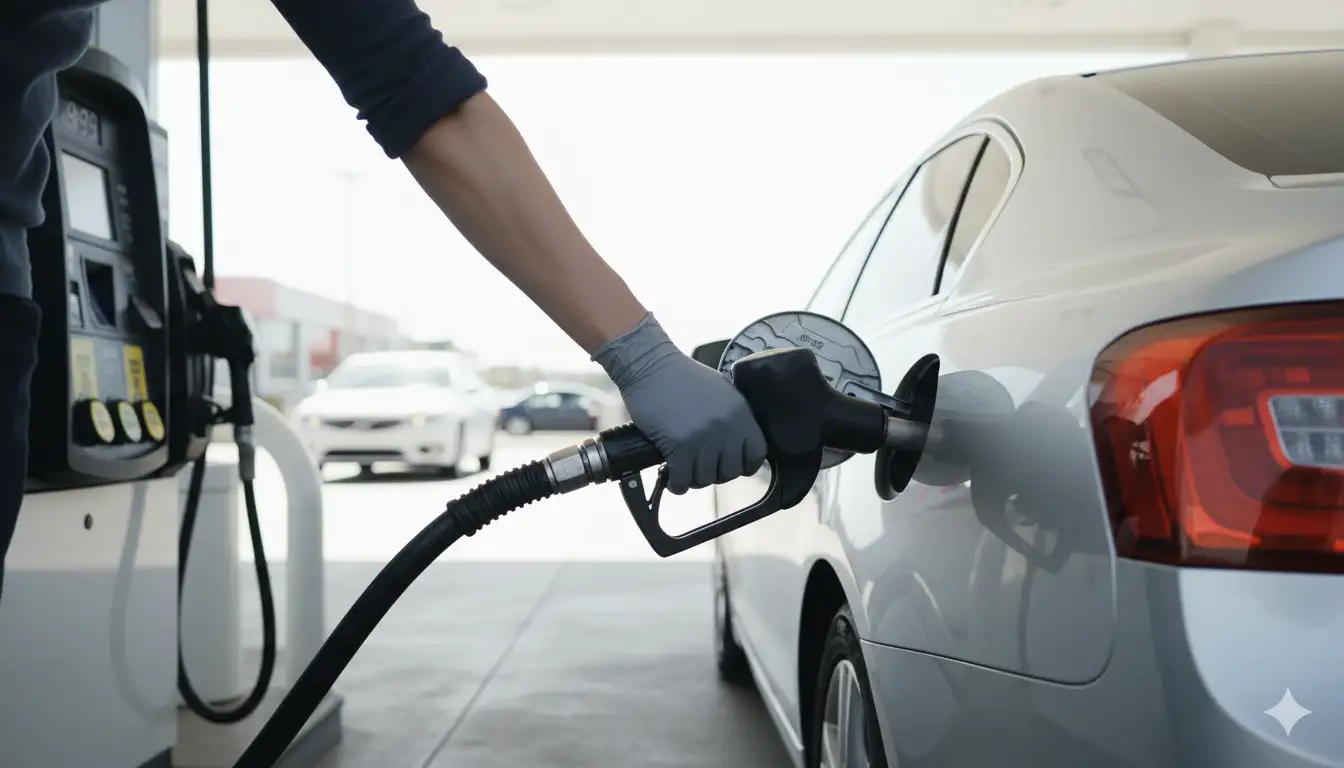You may also like:
- 【Explained】How to Get a Car with a Bad Fuel Pump to Start? (Temporary Hacks)
- 【Explained】Why does my car smell like gas but isn’t leaking?
- 【Explained】What Is the Gas Mileage of the R? (EPA vs. Real World)
- 【Explained】What Type of Gas Do BMW Take? Premium Fuel, Octane, and Knocking Explained
- 【Explained】What Gas Does the Civic Type R Take?
A typical car holds between 12 and 16 gallons of gas, though exact capacity varies significantly based on vehicle type, with compact cars averaging 12 gallons, sedans 14-18 gallons, SUVs 18-24 gallons, and trucks 20-40 gallons. Modern fuel tank designs balance weight, space efficiency, and driving range to optimize vehicle performance and convenience[1].

Average Gas Tank Size by Vehicle Type
Understanding fuel tank capacity across different vehicle categories helps drivers make informed decisions about their next vehicle purchase or plan long-distance trips more effectively. According to data from the EPA and major automotive manufacturers, fuel tank sizes have remained relatively consistent over the past decade, with minor variations based on evolving efficiency standards[2].
Compact Car Gas Tank Capacity
Compact cars prioritize fuel efficiency and urban maneuverability, resulting in smaller fuel tanks that still deliver impressive range. These vehicles represent the most popular segment for city dwellers and first-time car buyers seeking economical transportation.
Typical 12 Gallons of Gas Storage
The standard 12-gallon fuel tank found in most compact cars strikes an optimal balance between vehicle weight and practical range[1]. Popular models like the Honda Civic feature a 12.4-gallon tank, while the Civic Si holds 12.39 gallons, demonstrating remarkable consistency across trim levels[3]. This capacity allows compact cars to achieve 400-500 miles of range when combined with their excellent fuel economy ratings.
Manufacturers design these tanks to fit within the compact car’s limited chassis space while maintaining proper weight distribution. The fuel tank typically sits beneath the rear passenger area, protected by the vehicle’s frame structure. According to Autvex automotive experts, this 12-gallon standard has remained unchanged for over two decades because it perfectly matches compact car buyers’ needs.
The benefits of a 12-gallon tank extend beyond simple storage:
- Lower refueling costs averaging $35-45 per fill-up at current prices
- Reduced vehicle weight improving acceleration and handling
- Adequate range for daily commuting and weekend trips
- Faster refueling taking only 2-3 minutes at the pump
Mid-Sized and Full-Sized Sedans Fuel Tank Capacity
Sedan fuel tanks demonstrate greater variation based on vehicle positioning and target market. Luxury sedans often feature larger tanks to extend range between premium fuel stops, while economy sedans optimize for efficiency.
Average Fuel Tank Size 14-20 Gallons
Mid-sized sedans typically carry 14-18 gallons, providing the sweet spot for family vehicles that balance passenger space with fuel capacity[2]. The Toyota Camry exemplifies this range, with recent models featuring tanks between 13 and 17 gallons depending on the specific configuration—hybrid models use 13-gallon tanks while gas-only AWD versions hold 16 gallons[4].
Full-sized sedans push capacity to 18-20 gallons, catering to buyers who prioritize highway cruising range. These larger tanks support the increased fuel consumption of more powerful engines while maintaining competitive range figures. Premium brands like [BMW’s 5 Series] and [Audi’s A6] typically feature 17-18 gallon tanks, ensuring their luxury sedan buyers rarely need frequent fuel stops.
| Sedan Category | Tank Size Range | Popular Examples | Typical Range |
|---|---|---|---|
| Compact | 12-14 gallons | Honda Civic, Mazda3 | 400-450 miles |
| Mid-Size | 14-18 gallons | Toyota Camry, Honda Accord | 450-550 miles |
| Full-Size | 18-20 gallons | Chrysler 300, Dodge Charger | 400-500 miles |
| Luxury | 17-21 gallons | Mercedes E-Class, BMW 5 Series | 450-600 miles |
SUV Gas Tank Specifications
Sport Utility Vehicles require larger fuel tanks to compensate for their reduced fuel efficiency and support their adventure-ready capabilities. The tank size often correlates directly with the SUV’s overall size classification.
18-24 Gallons Average Capacity
Most SUVs feature fuel tanks in the 18-24 gallon range, though compact crossovers may have smaller 16-gallon tanks while full-size models exceed 24 gallons[1]. This capacity ensures adequate range despite SUVs’ typically lower fuel economy compared to sedans. The additional fuel storage compensates for the aerodynamic penalty and weight of these taller vehicles.
Popular SUV fuel capacities include:
- Compact SUVs (Honda CR-V, Mazda CX-5): 14-16 gallons
- Mid-size SUVs (Toyota Highlander, Honda Pilot): 18-21 gallons
- Full-size SUVs (Chevrolet Tahoe, Ford Expedition): 24-28 gallons
- Luxury SUVs (Range Rover, Cadillac Escalade): 22-31 gallons
The [Audi Q7] exemplifies the luxury SUV segment with its 22.5-gallon tank, providing excellent range for long family road trips while towing capabilities remain uncompromised.
Truck Gas Tank Size
Pickup trucks feature the largest fuel tanks among consumer vehicles, necessary to support their work capabilities and towing demands. Tank size often varies significantly based on cab configuration and bed length.
Pickup Trucks 20-26 Gallons
Standard pickup trucks typically include 20-26 gallon fuel tanks, though many manufacturers offer optional extended-range tanks[5]. The 2025 Ford F-150, America’s best-selling truck, comes standard with a 36-gallon tank on most trims, while the hybrid PowerBoost variant uses a 30.6-gallon tank to accommodate battery placement[5].
Modern pickup fuel tank options reflect diverse buyer needs:
- Compact pickups (Ford Maverick, Hyundai Santa Cruz): 16-18 gallons
- Mid-size pickups (Toyota Tacoma, Chevrolet Colorado): 18-21 gallons
- Full-size pickups (Ram 1500, GMC Sierra): 23-33 gallons
- Heavy-duty pickups (Ford F-250, Chevrolet Silverado HD): 34-48 gallons
Large Trucks 30-40 Gallons
Heavy-duty and commercial-oriented trucks push fuel capacity to 30-40 gallons or more, with some configurations exceeding 48 gallons[6]. These massive tanks support extended work cycles and long-distance hauling without frequent refueling stops. Aftermarket companies like Titan Fuel Tanks offer replacement units holding up to 65 gallons for specialized applications.
According to Autvex’s commercial vehicle analysis, larger fuel tanks provide critical operational advantages:
- Extended range for rural job sites or cross-country hauling
- Reduced downtime from fewer refueling stops
- Bulk fuel purchasing opportunities at lower prices
- Emergency reserve capacity for unexpected detours
How to Find Fuel Tank Size for Your Vehicle
Determining your specific vehicle’s fuel tank capacity requires consulting official sources rather than relying on generalizations. Multiple reliable methods exist to find this crucial specification.
Check Gas Tank Capacity in Vehicle Owner’s Manual
Your vehicle’s owner’s manual provides the most accurate fuel tank capacity information, typically found in the specifications or capacities section[3]. Modern digital owner’s manuals, like those from [Audi’s online portal] or BMW’s app, make this information instantly accessible on smartphones.
The owner’s manual typically lists:
- Total tank capacity in gallons and liters
- Usable capacity (actual fillable amount)
- Reserve fuel amount when low fuel light activates
- Fuel type requirements and octane ratings
- Approximate driving range calculations
Physical manuals usually dedicate an entire page to fluid capacities, making the information easy to locate. Digital versions offer search functions to quickly find “fuel tank” or “gas capacity” specifications.
Manufacturer Website Vehicle Specifications
Automotive manufacturer websites provide comprehensive specifications for all current and many historical models. These official sources offer the advantage of comparing different trim levels and configurations that might have varying tank sizes[2].
Where to find specifications online:
- Navigate to the manufacturer’s official website
- Select “Vehicles” or “Models” from the menu
- Choose your specific model and year
- Click on “Specifications” or “Tech Specs”
- Look under “Fuel & MPG” or “Capacities”
Most manufacturer sites also provide build-and-price tools showing how different options affect fuel capacity. For example, selecting all-wheel drive on certain models might reduce tank size to accommodate additional drivetrain components.
Gas Cap Information and Labels
Many vehicles display fuel capacity information on or near the fuel door, though this practice varies by manufacturer[1]. Some models include a label inside the fuel door listing tank capacity alongside fuel grade requirements.
Common label locations include:
- Inside fuel door on a white or yellow sticker
- Driver’s door jamb with tire pressure information
- Under hood on the emissions control label
- Glove box on newer vehicles with QR codes
However, these labels may fade or peel over time, making them unreliable for older vehicles. Additionally, aftermarket fuel doors might not include this information even if the original did.
Understanding Fuel Tank Capacity and Related Concepts
Fuel tank specifications involve more complexity than simple volume measurements. Understanding these nuances helps drivers maximize their vehicle’s efficiency and plan trips more effectively.
Fuel Tank Capacity vs Actual Usable Gallons
The advertised fuel tank capacity doesn’t represent the exact amount you can pump into your vehicle. Manufacturers build in safety margins and reserve capacity that affect real-world filling[4]. For instance, Toyota Camry owners often wonder why they can only add 13-15 gallons when the tank supposedly holds 16 gallons—this occurs because the low fuel light activates with 2.3 gallons remaining as a safety buffer.
Typical fuel capacity breakdown:
- Advertised capacity: Total tank volume
- Usable capacity: 90-95% of advertised
- Reserve fuel: 1.5-2.5 gallons after warning light
- Expansion space: 5-10% for fuel vapor and heat expansion
- Unusable fuel: 0.5-1 gallon below pump pickup
This design prevents several problems:
- Fuel pump damage from running completely dry
- Air lock in fuel injection systems
- Vapor lock in hot weather conditions
- Tank overflow during temperature changes
How Fuel Tank Size Affects Miles Per Gallon (MPG)
While fuel tank size doesn’t directly impact MPG ratings, it significantly influences practical driving considerations and vehicle design choices[7]. Larger tanks add weight that slightly reduces fuel economy, but this penalty is minimal compared to the convenience benefits.
Driving Range Calculations
Calculating driving range involves simple multiplication: tank capacity times MPG equals theoretical range. However, real-world range typically falls 10-15% below these calculations due to various factors[2].
Range Calculation Examples:
| Vehicle Type | Tank Size | Combined MPG | Theoretical Range | Realistic Range |
|---|---|---|---|---|
| Compact Car | 12 gallons | 35 MPG | 420 miles | 360-380 miles |
| Mid-Size Sedan | 16 gallons | 30 MPG | 480 miles | 410-430 miles |
| SUV | 20 gallons | 25 MPG | 500 miles | 425-450 miles |
| Pickup Truck | 26 gallons | 22 MPG | 572 miles | 485-515 miles |
Factors affecting actual range include:
- Driving style (aggressive vs. conservative)
- Traffic conditions (highway vs. city)
- Weather (headwinds, temperature extremes)
- Payload (passengers and cargo weight)
- Terrain (mountains vs. flatlands)
Fuel Efficiency Considerations
Engineers carefully balance fuel tank size against efficiency goals when designing vehicles. According to EPA data, every 100 pounds of weight reduces fuel economy by approximately 1-2%[7]. A full 20-gallon tank weighs about 120 pounds, creating a measurable impact on efficiency.
Modern manufacturers employ several strategies to optimize this balance:
- Plastic tanks weighing 50% less than steel
- Saddle-shaped designs maximizing space utilization
- Integrated baffles preventing fuel slosh
- Active fuel management systems adapting to fuel load
For drivers seeking maximum efficiency, consider [fuel-efficient used vehicles] that balance tank size with excellent MPG ratings.
Vehicle Weight and Fuel Storage Relationship
The relationship between vehicle weight and fuel storage creates interesting engineering challenges. Fuel represents one of the most variable weight components in any vehicle, changing by 6.1 pounds per gallon of gasoline[2].
Weight impact of full tanks:
- 12-gallon tank: 73 pounds of fuel
- 20-gallon tank: 122 pounds of fuel
- 30-gallon tank: 183 pounds of fuel
- 40-gallon tank: 244 pounds of fuel
This weight variation affects:
- Acceleration performance (slower when full)
- Braking distance (longer when heavy)
- Suspension geometry (changes with fuel level)
- Tire wear (increased with more weight)
Performance enthusiasts sometimes run with minimal fuel to reduce weight, though this practice risks fuel starvation during hard cornering. Autvex recommends maintaining at least quarter-tank levels for optimal fuel pump cooling and system reliability.

Units of Measurement for Fuel Capacity
Global variations in measurement systems create confusion when comparing fuel capacities across different markets. Understanding these differences helps when researching international vehicles or traveling abroad.
US Gallons vs Liters Conversion
The United States primarily uses gallons for fuel measurement, while most other countries use liters. One US gallon equals 3.785 liters, making conversion straightforward but essential for international comparisons[1].
Quick Conversion Reference:
| US Gallons | Liters | Imperial Gallons |
|---|---|---|
| 10 | 37.9 | 8.3 |
| 12 | 45.4 | 10.0 |
| 15 | 56.8 | 12.5 |
| 20 | 75.7 | 16.7 |
| 25 | 94.6 | 20.8 |
| 30 | 113.6 | 25.0 |
Conversion formulas:
- Gallons to Liters: Gallons × 3.785 = Liters
- Liters to Gallons: Liters ÷ 3.785 = Gallons
- US to Imperial Gallons: US Gallons × 0.833 = Imperial Gallons
International Fuel Tank Measurements
Different regions use varying standards for fuel capacity specifications, creating potential confusion for international car buyers or renters[8]. European and Asian manufacturers typically list capacities in liters even for US-market vehicles.
Regional measurement preferences:
- North America: US gallons (Canada uses liters at pumps but gallons in specs)
- Europe: Liters exclusively
- United Kingdom: Transitioning from imperial gallons to liters
- Asia: Liters (Japan sometimes uses different local measurements)
- Australia: Liters since metrication in 1970s
Understanding these differences proves especially important when:
- Importing vehicles from other markets
- Renting cars internationally
- Comparing specifications across global models
- Reading international automotive publications
The distinction between US and imperial gallons causes particular confusion. Imperial gallons are 20% larger than US gallons, meaning a UK-spec vehicle with a “15-gallon” tank actually holds 18 US gallons.
Practical Applications of Knowing Your Gas Tank Size
Understanding your vehicle’s fuel capacity extends beyond simple curiosity, offering practical benefits for daily driving and trip planning. This knowledge helps optimize fuel costs and avoid inconvenient situations.
Refueling and Trip Planning
Accurate knowledge of fuel tank capacity transforms trip planning from guesswork into precise calculation[1]. Drivers can determine exact fuel stops, budget requirements, and feasible destinations without range anxiety.
Trip planning calculations:
- Determine total distance using mapping apps
- Divide by your average MPG for gallons needed
- Compare to tank capacity for required stops
- Add 10-15% buffer for real-world variations
- Identify fuel stops at optimal intervals
For a 500-mile trip in a car with 16-gallon capacity getting 30 MPG:
- Fuel needed: 500 ÷ 30 = 16.7 gallons
- Minimum stops: 2 (one refuel en route)
- Optimal refuel point: 350-400 miles
- Budget needed: $50-60 at current prices
Mobile apps like GasBuddy integrate tank capacity with real-time fuel prices, helping drivers find the most economical refueling points along their route. For those considering new vehicles, understanding how the car buying process works includes evaluating fuel capacity needs.
Gas Mileage and Fuel Storage Management
Effective fuel management extends beyond knowing tank capacity to understanding how driving habits affect consumption[2]. Drivers who track their actual MPG against EPA estimates can make more accurate range predictions.
Fuel management best practices:
- Never run below 1/4 tank to protect fuel pump
- Fill up at 1/2 tank in winter to prevent condensation
- Track actual MPG over several tanks
- Adjust expectations based on driving conditions
- Plan fuel stops before prices spike
Modern vehicles with trip computers simplify this tracking, but manual calculation remains valuable:
- Miles driven ÷ Gallons used = Actual MPG
- Track over 3-5 tanks for accuracy
- Compare to EPA ratings to identify issues
Strategic refueling based on tank capacity can generate significant savings. According to Autvex analysis, drivers who plan fuel stops at lower-price stations save an average of $156 annually compared to convenience refueling.

Key Takeaway
A typical car holds between 12-16 gallons of gas, but capacity varies significantly across vehicle categories: compact cars average 12 gallons, sedans range 14-18 gallons, SUVs carry 18-24 gallons, and pickup trucks hold 20-40 gallons depending on configuration. Understanding your specific vehicle’s fuel tank capacity—found in the owner’s manual or manufacturer specifications—enables better trip planning, fuel budgeting, and helps maximize your vehicle’s designed range capabilities[1].
Next Steps
Check your vehicle’s owner’s manual or manufacturer website to confirm exact fuel tank capacity, then calculate your real-world driving range by multiplying tank size by your actual MPG from recent driving. Use this information to plan fuel stops on long trips, budget monthly fuel expenses more accurately, and determine if your current vehicle’s tank capacity meets your driving needs. Consider tank capacity alongside fuel efficiency when shopping for your next vehicle, as the combination determines practical range and refueling frequency.
FAQs
How many gallons does a typical car hold?
Most cars hold between 12-16 gallons, with exact capacity varying by vehicle size and type[1]. Compact cars typically hold 12 gallons, mid-size sedans 14-18 gallons, while SUVs and trucks can hold 20-40 gallons depending on their size and configuration.
Where can I find my car’s fuel tank capacity?
Check your vehicle owner’s manual in the specifications section, visit the manufacturer’s website for your model’s tech specs, or look for labels inside the fuel door or driver’s door jamb[3]. Digital owner’s manuals and manufacturer apps provide instant access to this information.
How does fuel tank size affect driving range?
Multiply your tank capacity in gallons by your vehicle’s MPG to calculate theoretical range, though real-world range typically falls 10-15% below calculations[2]. Larger tanks provide longer range between fill-ups but add weight that slightly reduces fuel efficiency, creating a balance manufacturers carefully optimize.
References
- Edmunds. (2025). How many gallons of gas does a car hold? Retrieved from https://www.edmunds.com/car-maintenance/how-many-gallons-of-gas-does-car-hold.html
- Mills Equipment. (2024). Understanding Average Fuel Tank Size. Retrieved from https://millsequipment.com/blogs/blogs/understanding-average-fuel-tank-size-what-you-need-to-know
- Honda. (2024). Honda Civic MPG – Fuel Efficiency Meets Style. Retrieved from https://www.darcarshondaoffairfax.com/honda-civic-mpg.html
- Toyota. (2025). Toyota Camry Gas Tank Size (By Model Years). Retrieved from https://camryguides.com/toyota-camry-gas-tank-capacity/
- Ford. (2025). 2025 Ford F-150 Gas Tank Size and Mileage Overview. Retrieved from https://www.permianford.net/blog/2025/march/28/2025-ford-f-150-gas-tank-size-mileage.htm
- Titan Fuel Tanks. (2025). 2018-2021 FORD F150 Crew Cab Replacement Tank. Retrieved from https://titanfueltanks.com/2018-19-ford-f150-crew-cab-short-bed-generation-6-titan-fuel-tank-48-gallons-7021218
- EPA. (2025). Average Fuel Economy by Major Vehicle Category. Retrieved from https://afdc.energy.gov/data/10310
- NHTSA. (2024). Corporate Average Fuel Economy (CAFE). Retrieved from https://www.nhtsa.gov/laws-regulations/corporate-average-fuel-economy

I am a senior automotive analyst at Autvex. Expert vehicle evaluations, in-depth reviews, and objective analysis helping readers make informed automotive decisions with years of industry experience.









